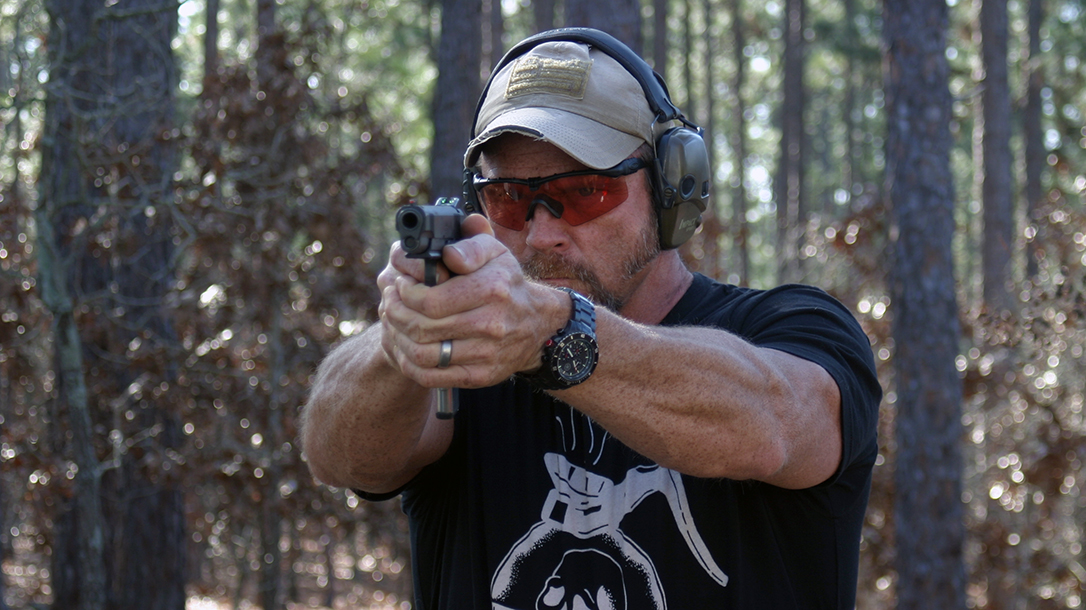When it comes to pistol training fundamentals, too many are too eager to say too much. The message becomes a bunch of watered-down, esoteric minutiae that is no longer palatable to the intended recipient. I believe that when you’re teaching, it’s important to say the right thing to the right person at the right time. And it is just as equally important to know what not to say. The clarity by which something is defined determines the effectiveness of its application.
There are many brain-default mechanisms that we can rely on when it comes to pistol training and application of the fundamentals. Either we rely on the brain’s default mechanisms or we go against it. One of the things I repeat during my courses is that we sometimes have to put the analytical mind aside and allow the body to work. Allow me to draw some examples of things taught that I think are either unnecessary or are wrong.
Advertisement — Continue Reading Below
Pistol Training Stance
Stance is typically considered a fundamental of marksmanship, but I would argue that it is not a fundamental of fighting marksmanship whatsoever. The reason? In a fight, we probably won’t get to choose our stances. Too many instructors spend too much time teaching shooters how to stand up. Because of that, my version of teaching stance as a fundamental is “Go ahead and stand up.” Footing is and should be considered more apt when describing how our feet and legs support our shooting platform. Take away the perfect modified-isosceles, super-arched turtle-back stance and simply stand up. There. You are good to go. Knowing where your feet are in relationship to your body is what matters when considering your base. You can’t always fight on flat ground in a gunfight. It might be uneven. You may be on the move. You may be firing from behind cover.
Get a Grip on Pistol Training
Another dogma that I hear is how your firing grip should be a ratio of 30-percent firing hand and 70-percent support hand. What? How do I measure this? What if I am 40/60 or 45/55? Am I going to be a soup sandwich, a chicken-wire canoe, a football bat or hockey cleats? In my classes, I simply state that as you grip the pistol and during your drawstroke, your grip should get tighter as you present the gun. Think of it like a clamshell of sorts. Physics over strength.
Since we’re talking about presentations, I am often asked how far we should push the pistol out, and whether our elbows should be elevated, neutral or oriented downward. “I don’t know,” I answer. “What does your brain tell your body to do?”
Advertisement — Continue Reading Below
The thing is, we human beings know where our body’s natural arm extension is. It varies from human to human. When we reach for something close by, there is typically a slight bend in the elbow during a natural extension. Put the analytical mind aside and allow your body to do its thing.
Triggered
“It should surprise you when it goes off.” This horrible advice is given too often when explaining trigger control. I’ve been surprised when my gun went off on a few occasions. It’s called an “oops.” Too much prep on the way to my extension. You know who else is surprised when a gun goes off? Those who have had accidental or negligent discharges. You bet your sweet ass that those guys were surprised. The thing is, we should know exactly when the hammer (or striker) is going to fall. It’s called training, and most of this is done through dry firing. As responsible gun handlers, we need to be able to fire with impunity. Nothing should be a surprise when we have made a decision to fire.
To Cant or Not to Cant
Advertisement — Continue Reading Below
“I was taught to cant my pistol when I fire strong- or support-hand only.” Well, you were taught wrong. Once again, what does your brain tell your body to do? Mine tells me to orient straight on when I am firing with just my strong hand. When I fire support-hand only, my brain tells my body to cant the pistol slightly.
Slingshot or Slide Lock
“How do I get the pistol back into action once the slide locks back? I was told to always release the slide using my support-hand thumb.” Nope. Stop. My answer is simple: “Get the pistol back into action.” Whether you are working the slide, slide lock or using the slingshot technique, you are correct if the gun is put back in action. That said, I personally am not a fan of reaching over the top of the slide. I’ve seen too many bad things happen using that technique.
Rely on your brain’s default mechanisms when you work most of the shooting fundamentals. There are no cut-and-dried, black-and-white answers for the fundamentals, as they vary a bit from human to human.
Advertisement — Continue Reading Below
This article was originally published in Combat Handguns May/June 2019. To order a copy, please visit outdoorgroupstore.com.
























